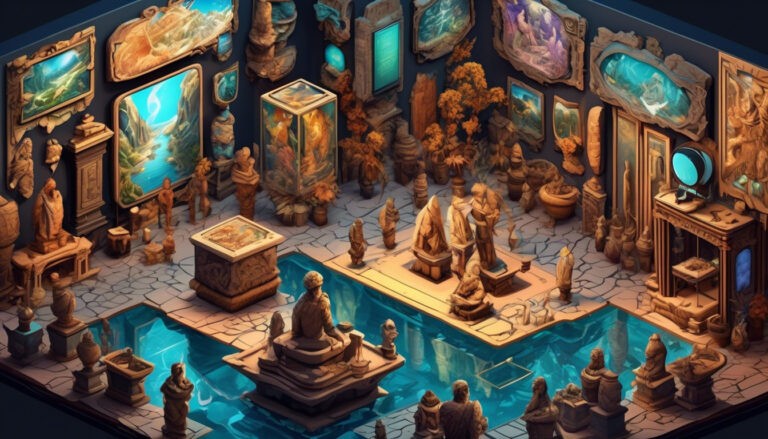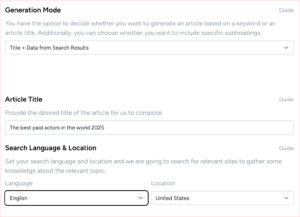In today’s digitally-driven world, virtual tours and exhibitions have become a cornerstone for museums, galleries, and educational institutions aiming to extend their reach beyond physical boundaries. AI-generated content is revolutionizing this space, offering richer, more engaging user experiences that captivate audiences globally.
By integrating advanced AI tools, creators can now craft detailed, interactive narratives that weren’t possible before, making every virtual visit both educational and mesmerizing.
This article delves into how AI technologies are being harnessed to enhance virtual tours and exhibitions, pushing the boundaries of what’s possible in digital storytelling and visitor engagement.
AI-Generated Descriptions
AI-generated descriptions can significantly enhance your virtual tour experience by providing vivid, accurate portrayals of locations and artifacts. As you navigate through digital spaces, these smart tools deliver concise, informative details tailored to your interests and comprehension level. They adapt in real-time, ensuring you’re not just visiting, but truly understanding the significance of each site.
Imagine stepping into a historical building; the AI immediately presents its history, architectural style, and notable events associated with it, all crafted to engage and inform you specifically. This personalized approach helps deepen your connection to the content, making each virtual visit uniquely enriching.
It’s not just about seeing the world—it’s about comprehending and appreciating its richness, directly tailored to your curiosity.
Virtual Environment Enhancement
To enhance your virtual tour experience, AI steps in to refine and enrich the environments you’re exploring. Imagine walking through a digitally recreated art gallery where the lighting adjusts dynamically to mimic the time of day in the artwork’s original setting, or strolling through a historical site with weather effects that change to reflect historical conditions. AI-generated content doesn’t just replicate reality; it enhances it, making your virtual visit more immersive and engaging.
By integrating AI, textures and details are enhanced to near-photorealistic quality, ensuring every element from the cobblestone paths to the rustling leaves adds depth to your virtual exploration. This technology transforms standard virtual tours into captivating, lifelike experiences that are as enriching as visiting the real locations.
Interactive Exhibit Presentations
AI-driven interactive exhibit presentations allow you to engage directly with displays, asking questions and receiving tailored information in real-time. This dynamic interaction transforms your experience from passive observation to active exploration. As you interact, the AI assesses your responses and interests, dynamically adjusting the content to better suit your curiosity.
Additionally, these presentations can include multimedia elements like videos, images, and AR overlays, making learning more immersive and engaging. You’re not just looking; you’re experiencing and influencing the exhibition.
This technology also enables access to expert insights without needing a human guide present, providing depth and context whenever you desire. It’s like having a personal tour guide who instantly responds to your every query.
Personalized Tour Experiences
AI-generated content personalizes your virtual tour by adapting to your preferences and interests in real time. Imagine logging in to a virtual museum tour and the exhibits you see first are tailored to your love of impressionist art or ancient history.
It tracks what catches your eye and suggests similar artifacts you might enjoy. You won’t waste time on exhibits that don’t spark your curiosity. This personalization makes each visit unique, ensuring that no two tours are the same.
It’s like having a private guide who knows exactly what fascinates you. Plus, the more you explore, the smarter it gets, refining each experience to better suit your taste. This way, every form of tour becomes more engaging and deeply enriching.
Dynamic Content Creation
AI technology dynamically generates content that evolves as you interact with your virtual environment, ensuring a continuously fresh and relevant experience.
Imagine walking through a digital museum where each exhibit updates to reflect your interests and past interactions. You’re not just a passive viewer; you’re a catalyst for change, influencing the story that unfolds.
This dynamic creation isn’t just about keeping things interesting; it’s about deepening your connection with the content. Each visit feels unique, tailored just for you, making you more engaged and possibly even eager to return.
What’s more, this approach allows cultural and historical exhibitions to stay up-to-date without constant manual updates, seamlessly blending educational value with personalized engagement.
Real-Time Data Integration
Real-time data integration enhances your virtual tour experience by instantly updating the environment based on the latest information available. Imagine walking through a virtual museum where exhibits shift to show the most current discoveries, artworks, or even visitor statistics. This seamless update isn’t just about seeing new items; it’s about experiencing them in the context that’s most relevant today.
Your experience becomes more immersive and informative as data from the latest research or trending social media feeds are integrated in real-time. This means you’re not just looking at history or art; you’re interacting with an environment that reflects the current state of knowledge and public interest, keeping the content fresh and engaging without straying into the next subtopic’s focus on user engagement.
Enhanced User Engagement
Enhanced user engagement transforms your virtual tour into an interactive and personalized journey. By leveraging AI, you’re not just observing; you’re participating. Imagine AI chatbots that respond to your queries in real-time, making you feel like you’re conversing with a guide. These bots can adapt interactions based on your interests, keeping you hooked and eager to explore more.
Interactive quizzes pop up, testing your knowledge and offering instant feedback. This isn’t just about looking at exhibits; it’s about engaging with them, learning actively.
You’re no longer a passive visitor but an active participant. Each click reveals new content tailored just for you, making every virtual visit unique. This level of interaction ensures you’re not only informed but genuinely entertained.
Customized Virtual Exhibition Themes
You can tailor your virtual exhibition themes to reflect your personal interests or professional expertise, enhancing the immersion and relevance of your experience. Imagine walking through a digital gallery crafted around your favorite historical era or the latest tech innovations.
AI tools enable these personalized themes by analyzing your preferences and generating content that resonates with you. Whether you’re an art aficionado or a science enthusiast, the exhibitions adapt to meet your curiosity.
This customization not only makes the virtual tours more engaging but also helps in deepening your understanding of the subjects you’re most passionate about. With each visit, you’ll discover new facets and details, creating a continually evolving educational landscape that’s as unique as you are.
How can intellectual property rights be managed when using AI to generate content for virtual tours and exhibitions?
When using AI to create content for virtual tours and exhibitions, manage intellectual and property rights by clearly defining ownership and licensing agreements, and ensuring compliance with copyright laws.
Protect your creations and respect others’ rights.
What are the ethical considerations when using AI-generated avatars or representations of historical figures?
When using AI-generated avatars or representations of historical figures, consider ethical implications. Respect accuracy, cultural sensitivity, and potential impact on narratives.
Ensure transparency about AI involvement to maintain trust and authenticity in storytelling.
How does AI-generated content integrate with existing digital asset management systems in museums and galleries?
When integrating AI-generated content with existing digital asset management systems in museums and galleries, you’ll find improved organization and accessibility.
The potential for enhanced visitor experiences through innovative storytelling and interactive exhibits is also significant.
Conclusion
In conclusion, AI-generated content offers a promising avenue for enriching virtual tours and exhibitions. By leveraging advanced technologies, such as machine learning and natural language processing, organizations can create immersive and interactive experiences for their audiences.
The ability of AI to generate personalized and engaging content opens up new possibilities for enhancing the way we explore and interact with virtual environments.
Embracing these innovations can lead to a more dynamic and enriching experience for users in the realm of virtual tours and exhibitions.





